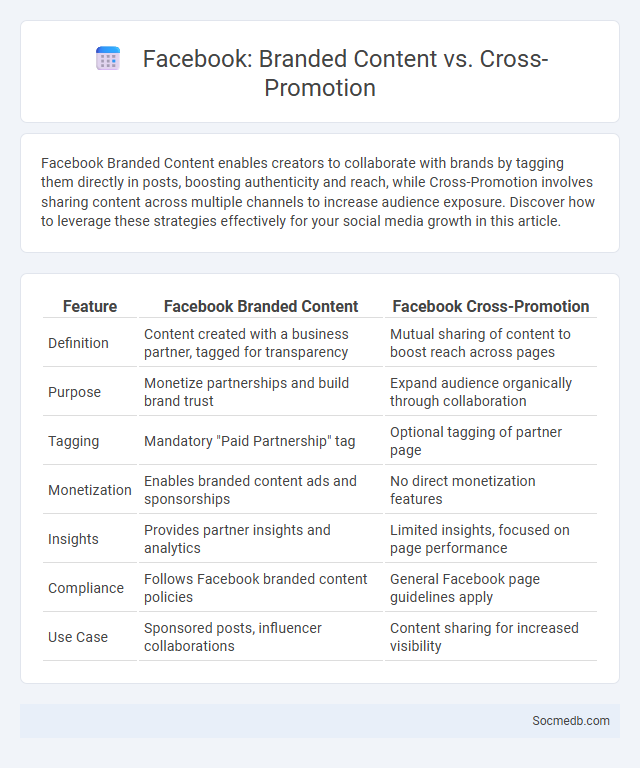
Photo illustration: Facebook Branded Content vs Cross-Promotion
Facebook Branded Content enables creators to collaborate with brands by tagging them directly in posts, boosting authenticity and reach, while Cross-Promotion involves sharing content across multiple channels to increase audience exposure. Discover how to leverage these strategies effectively for your social media growth in this article.
Table of Comparison
| Feature | Facebook Branded Content | Facebook Cross-Promotion |
|---|---|---|
| Definition | Content created with a business partner, tagged for transparency | Mutual sharing of content to boost reach across pages |
| Purpose | Monetize partnerships and build brand trust | Expand audience organically through collaboration |
| Tagging | Mandatory "Paid Partnership" tag | Optional tagging of partner page |
| Monetization | Enables branded content ads and sponsorships | No direct monetization features |
| Insights | Provides partner insights and analytics | Limited insights, focused on page performance |
| Compliance | Follows Facebook branded content policies | General Facebook page guidelines apply |
| Use Case | Sponsored posts, influencer collaborations | Content sharing for increased visibility |
Understanding Facebook Branded Content
Facebook Branded Content allows businesses and creators to publish sponsored posts that clearly identify partnerships, enhancing transparency and trust with audiences. Leveraging Facebook's branded content tool enables precise targeting and analytics to measure campaign performance effectively. Proper use of branded content not only complies with Facebook's policies but also maximizes brand visibility and engagement across the platform.
What Is Cross-Promotion on Facebook?
Cross-promotion on Facebook involves leveraging multiple accounts, pages, or groups to share content and encourage audience engagement across different communities. This strategy maximizes reach by targeting diverse but related audiences, enhancing brand visibility and driving traffic between linked profiles or business pages. Effective cross-promotion boosts follower growth, improves post engagement rates, and supports integrated marketing campaigns within the Facebook ecosystem.
Defining Branded Content Beyond Facebook
Branded content extends far beyond Facebook, encompassing Instagram's visual storytelling, TikTok's short-form videos, and LinkedIn's professional narratives to engage diverse audiences effectively. Platforms like YouTube offer long-form branded videos that build deeper connections, while Twitter facilitates real-time branded conversations and trending hashtag campaigns. Leveraging multi-platform branded content strategies enhances brand visibility and drives consumer interaction across the digital ecosystem.
Key Differences: Branded Content vs. Cross-Promotion
Branded content involves creating original media that highlights a brand's values and products, often designed to engage audiences with storytelling and authentic messaging. Cross-promotion leverages partnerships between brands or platforms to share content, expanding reach and tapping into each other's followers without producing unique branded narratives. While branded content emphasizes deep brand integration and emotional connection, cross-promotion focuses on audience sharing and mutual visibility across different channels.
Facebook Branded Content: Features and Benefits
Facebook Branded Content provides tools for businesses and creators to share sponsored posts transparently, enhancing audience trust and engagement. Your brand can leverage features like taggable partnerships, detailed insights, and payment integrations to optimize campaign performance and measure ROI effectively. These benefits drive authentic connections and increase visibility across Facebook's vast user base.
Effective Strategies for Cross-Promotion on Facebook
Leveraging Facebook's diverse tools such as Groups, Pages, and Marketplace enhances cross-promotion by reaching varied audience segments. Utilizing Facebook Ads Manager to create targeted ad campaigns amplifies visibility and engagement across related platforms like Instagram and Messenger. Consistent branded content paired with interactive posts increases follower retention and drives traffic to linked social media channels.
Compliance and Policies for Facebook Branded Content
Facebook Branded Content policies require strict adherence to transparency by clearly labeling paid partnerships to maintain compliance with advertising standards. You must ensure all branded posts disclose sponsorships accurately and follow Facebook's Commerce Policies to avoid violations and potential penalties. Regularly reviewing Facebook's guidelines helps safeguard your account and uphold trust with your audience.
Measuring ROI: Branded Content vs. Cross-Promotion
Measuring ROI on social media requires analyzing key metrics such as engagement rates, conversion rates, and audience reach for both branded content and cross-promotion strategies. Branded content often delivers higher brand awareness and emotional connection, while cross-promotion leverages partnerships to expand your audience more quickly. Understanding these differences allows you to allocate your budget effectively and maximize returns from your social media campaigns.
Best Practices for Each Content Strategy
Effective social media content strategies require consistent audience analysis to tailor posts that maximize engagement and reach. Visual content, such as images and videos, should be optimized for each platform's specifications to enhance visibility and user interaction. You must schedule posts during peak activity hours and leverage analytics tools to refine your approach and boost conversion rates.
Choosing the Right Approach for Your Brand
Selecting the optimal social media strategy enhances brand visibility by aligning content types with target audience preferences and platform algorithms. Data-driven decisions, such as analyzing engagement metrics and audience demographics, refine campaign effectiveness and boost ROI. Tailoring messaging consistently across channels ensures brand identity strength while adapting to the unique tone of each social network fosters authentic connections.
 socmedb.com
socmedb.com